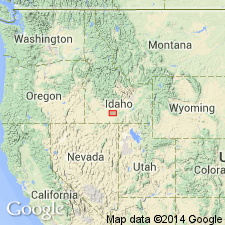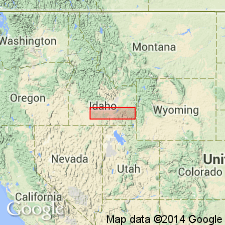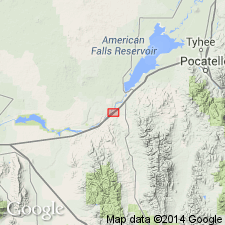
- Usage in publication:
-
- Eagle Rock tuff*
- Modifications:
-
- Original reference
- Dominant lithology:
-
- Tuff
- AAPG geologic province:
-
- Snake River basin
Summary:
Pg. 434-439; H.T. Stearns, 1932 (Correlation chart of Idaho compiled by M.G. Wilmarth, dated Sept 1, 1932). Eagle Rock tuff. Well-defined sequence of rhyolite tuffs, 35+/- feet thick, exposed at base of American Falls and at Eagle Rock, northeast of Massacre Rocks, Power Co., southern Idaho. Older than Massacre volcanics and younger than Neeley lake beds. Age is Pliocene(?) (early Pliocene?).
Source: US geologic names lexicon (USGS Bull. 896, p. 651).

- Usage in publication:
-
- Eagle Rock tuff*
- Modifications:
-
- Principal reference
- AAPG geologic province:
-
- Snake River basin
Summary:
Pg. 32 (table), 44-46, pls. 4-6. Eagle Rock tuff. Thickness about 35 feet. Shown on stratigraphic column above Neeley lake beds and below Massacre volcanics. Age is early Pliocene(?). Type locality designated.
Type locality: north bank of Snake River at American Falls, Power Co., southern ID. [Named from Eagle Rock which is near American Falls.]
Source: US geologic names lexicon (USGS Bull. 1200, p. 1198-1199); supplemental information from GNU records (USGS DDS-6; Denver GNULEX).

- Usage in publication:
-
- Eagle Rock tuff†
- Modifications:
-
- Abandoned
- AAPG geologic province:
-
- Snake River basin
Summary:
Pg. 23. †Eagle Rock tuff. Renamed Walcott welded tuff to avoid confusion with basaltic tuff that originated at locality of Eagle Rock.
Source: US geologic names lexicon (USGS Bull. 1200, p. 1198-1199).
For more information, please contact Nancy Stamm, Geologic Names Committee Secretary.
Asterisk (*) indicates published by U.S. Geological Survey authors.
"No current usage" (†) implies that a name has been abandoned or has fallen into disuse. Former usage and, if known, replacement name given in parentheses ( ).
Slash (/) indicates name conflicts with nomenclatural guidelines (CSN, 1933; ACSN, 1961, 1970; NACSN, 1983, 2005, 2021). May be explained within brackets ([ ]).

